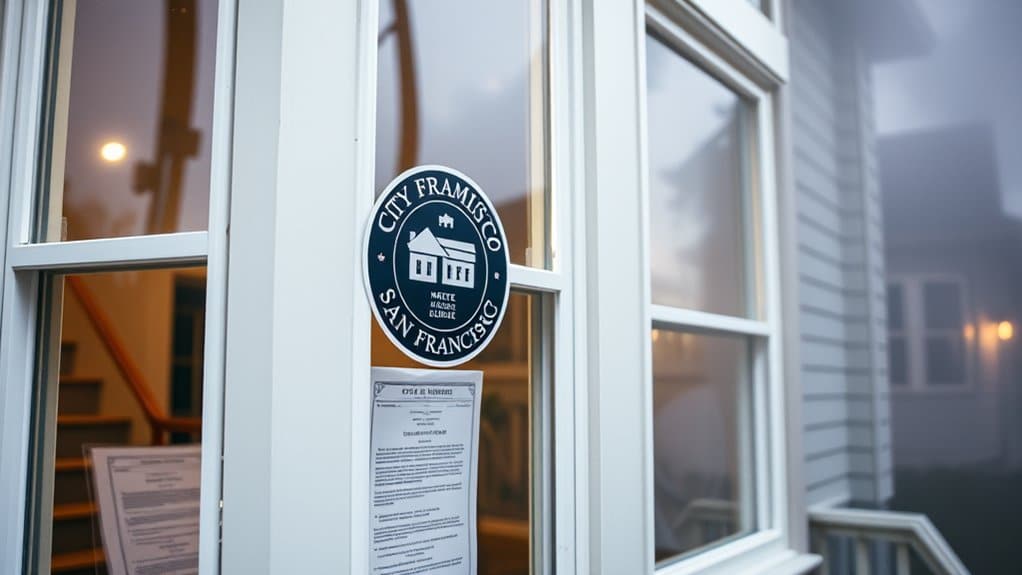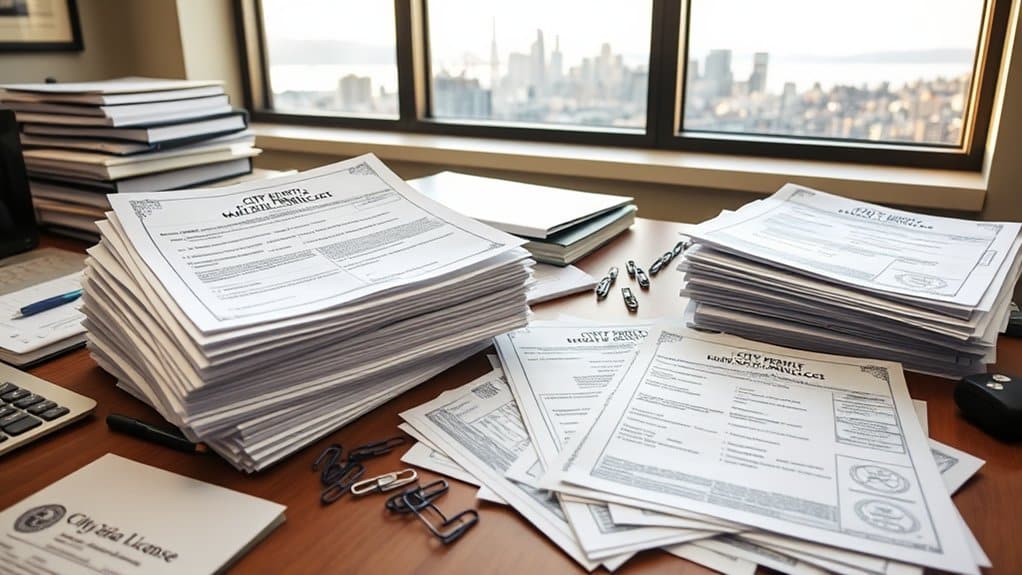When arriving in San Francisco for short-term housing, you'll need to navigate several key requirements and options. Popular platforms like Airbnb, VRBO, and Booking.com offer diverse rental choices across neighborhoods like Nob Hill, SOMA, and the Mission District. You'll find daily rates averaging $215, with monthly costs ranging from $2,259 to $5,050. Be prepared for the 14% Transient Occupancy Tax and standard rental fees. Look for properties with essential amenities, good transit access, and proper registration numbers displayed on listings. The city's competitive market and specific regulations make advance planning vital for securing your ideal temporary home. The following sections will guide you through each critical step.
Legal Requirements for SF Rentals

Before listing your San Francisco property as a short-term rental, you'll need to meet several key legal requirements. You must obtain both a Short-Term Residential Rental Certificate and a Business Registration Certificate to avoid legal implications down the road.
To address compliance challenges, you'll need to prove the property is your primary residence, which means you live there at least 275 nights per year. A registration number must be displayed on all your rental listings. Properties like affordable housing units and student dormitories are ineligible for short-term rentals.
You're required to maintain $500,000 in liability insurance and keep detailed compliance records for two years. The city's building, safety, and rent stabilization codes must be followed strictly. You'll need to pay a non-refundable fee of $750 during the application process.
If you're planning to rent while you're away, remember that unhosted rentals are limited to 90 nights annually. You'll also need to renew your registration each year to maintain your rental eligibility.
Finding Your Perfect Short Stay
Finding your ideal short-term rental in San Francisco requires careful consideration of both location and amenities.
You'll want to match your neighborhood preferences with your lifestyle needs, whether that's the Marina's convenient parking or Pacific Heights' stunning views. To enhance your browsing experience, many rental websites use essential cookies to save your search preferences. Online platforms like PadMapper and Apartments.com can help you explore over 1,000 options across the city. Kasas rentals provide competitive rates compared to typical city hotels.
Consider what ideal amenities matter most to you. If you need a fitness center and concierge service, look at properties like 901 California St in North Beach.
For those seeking outdoor space and pet-friendly options, explore rentals in the Marina district. You'll find various accommodation types, from shared rooms to entire houses, with flexible lease terms up to six months.
Resources like VRBO and Airbnb offer additional choices to match your specific requirements.
Costs and Financial Planning

When you're planning to operate a short-term rental in San Francisco, you'll need to prepare for significant upfront costs, including the required $500,000 liability insurance, business registration fees, and property preparation expenses.
Your monthly income potential ranges from $2,259 to $5,050, but you must account for the 14% Transient Occupancy Tax, regular maintenance costs, and utility expenses that come with frequent guest turnover.
Beyond the obvious expenses, you'll want to budget for hidden fees such as Business Personal Property Tax, cleaning services between stays, and emergency repair funds to maintain your property's competitive edge in the market.
Initial Costs to Budget
Starting a short-term rental business in San Francisco requires careful budgeting for four major upfront costs.
You'll need to account for essential expense categories, including application and registration fees totaling $925 for two years, plus an annual fee of $550.
As part of your initial budget considerations, you must secure liability insurance with minimum coverage of $500,000 to protect against accidents and damages.
You'll also need to invest in quality furnishings and supplies, from bedding to toiletries, to meet guest expectations.
Don't forget to factor in higher utility costs due to guest usage, and plan for regular cleaning services, which can range from $65 to $200 per turnover.
These expenses form the foundation of your business, so it's vital to budget accurately before launching your rental.
Monthly Rates vs. Expenses
To maximize your short-term rental profits in San Francisco, you'll need to balance daily rates against substantial operating costs. With average daily rates of $215 and monthly rental income potential ranging from $3,585 to $5,247, your expense breakdown requires careful attention.
Consider these major monthly expenses that will impact your bottom line:
- Hosting and management fees consume 10% of your revenue
- Utilities (gas, electric, water, internet) total around 7.5% of earnings
- The 14% Transient Occupancy Tax takes a significant portion
- Maintenance costs range from 10-15% of operating income
You'll need to factor in a 3.7% vacancy loss rate when calculating your monthly income potential.
Understanding these expenses helps you set competitive rates while maintaining profitability in San Francisco's dynamic rental market.
Hidden Fees Guide
Many San Francisco short-term rental hosts are caught off guard by the extensive hidden fees and regulatory costs.
You'll need to budget for the 14% Transient Occupancy Tax on your rental income, plus a $925 registration fee that's valid for two years. The hidden costs don't stop there - you're responsible for Business Personal Property Tax on your furnishings and quarterly reporting requirements.
Unexpected fees can include maintenance repairs, utility bills during vacant periods, and insurance coverage.
You'll need to factor in regular upkeep of appliances and furniture to maintain your rental's quality. If you're not compliant with regulations, you could face penalties starting at $484 per day.
Neighborhood Selection Guide
When choosing a neighborhood for your short-term rental in San Francisco, you'll find distinct characteristics across popular districts like Nob Hill's upscale quiet, SOMA's urban energy, and the Mission's vibrant culture.
Your selection should factor in both safety considerations and transit access, with areas like Nob Hill offering excellent walkability and public transportation while the Tenderloin presents more urban challenges despite its central location.
The Mission and SOMA provide different experiences for visitors, with the Mission featuring classic Victorian homes and a lively atmosphere, while SOMA delivers a more metropolitan feel with convenient freeway access and larger living spaces. Understanding the importance of transportation access can greatly enhance your experience in the city.
Popular Districts Overview
San Francisco's diverse neighborhoods offer distinct experiences for short-term visitors, from bustling urban centers to quiet residential havens.
You'll find unique neighborhood attractions and dining experiences that suit your travel style across various districts.
- The Mission District welcomes you with colorful street art and authentic Latino culture, featuring some of the city's best restaurants and vibrant nightlife.
- Pacific Heights delivers upscale charm with stunning bay views and access to historic parks, perfect for sophisticated urban explorers.
- Potrero Hill offers a sunny microclimate and spectacular skyline views, combining modern conveniences with historic character.
- SoMa and Union Square put you at the heart of the action, with easy access to shopping, entertainment, and public transportation.
Each area provides its own blend of amenities and atmosphere, making it essential to choose based on your preferences and planned activities.
Safety and Transit Access
While choosing the right neighborhood sets the foundation for your stay, understanding safety considerations and transit options will help you make the most informed decision.
You'll want to prioritize safety awareness by following local host guidance and avoiding areas that aren't recommended for tourists, especially after dark. Keep valuables secure and stay alert in all neighborhoods.
For transit efficiency, you'll find San Francisco offers multiple transportation options. The extensive public transit system includes BART, Muni buses, trains, and iconic cable cars.
You can easily navigate the city using the Munimobile app and a Clipper Card, which provides access to various transit services. When planning your routes, consider peak hours to avoid congestion, and remember that rideshare services and bike rentals offer additional flexibility for getting around.
Essential Documentation for Registration

Two essential certificates are required to legally operate a short-term rental in San Francisco.
You'll need to obtain a Business Registration Certificate from the Tax Collector's office and a Short-Term Residential Rental Certificate, which costs $750 in non-refundable fees.
During the registration process, you must prove that the property is your primary residence by providing specific documentation requirements.
Key items you'll need to complete your registration include:
- Two documents proving your primary residency, such as a California Driver's License or SF City ID
- Proof that you live in the unit for at least 275 nights per year
- Liability insurance coverage of at least $500,000
- A complete application that staff will review within 30 days
Popular Short-Term Housing Options
A vibrant array of short-term rental options awaits visitors in San Francisco, with platforms like PadMapper, Hello Landing, Zillow, VRBO, and Sonder offering diverse accommodations across the city.
You'll find affordable accommodations ranging from studio apartments starting at $67 per night in West of Twin Peaks to luxury properties in Seacliff.
For unique stays, you can choose from various neighborhoods that match your preferences.
Downtown San Francisco provides amenity-rich buildings with fitness centers and concierge services, while the Marina offers properties with garage parking and outdoor spaces.
If you're seeking more budget-friendly options, West of Twin Peaks features practical amenities like on-site laundry.
The Mission area combines affordability with perks such as swimming pools, making it an attractive choice for short-term visitors.
Rental Platforms and Booking Methods

When exploring short-term rentals in San Francisco, you'll find three dominant platforms leading the market: Airbnb, VRBO, and Booking.com.
Current rental trends show that each platform offers unique advantages for finding your temporary home. To make the most of these platforms and develop effective booking strategies, consider these key features:
- Airbnb excels with its user-friendly interface and robust communication tools, serving over 200 million users worldwide.
- VRBO specializes in vacation homes and larger properties, perfect for family stays.
- Booking.com provides extensive search filters and significant exposure, with 895 million nights booked in 2022.
- All platforms offer secure payment processing and various pricing options.
Remember to check each listing's registration number, as San Francisco regulations require hosts to display this information prominently on their listings.
Navigating Property Restrictions
Before booking your short-term rental in San Francisco, understanding the city's strict property restrictions will help you avoid potential legal issues.
Property eligibility varies considerably across the city, and you'll need to confirm that your chosen rental isn't in a prohibited category.
You can't rent properties in affordable housing units, student dormitories, or buildings with Ellis Act evictions after November 2014. Additionally, rental compliance requires that hosts must live in the property for at least 275 nights per year, and unhosted stays are limited to 90 nights annually.
If you're considering a unit in a multi-building complex, you'll need to verify it meets zoning requirements and building codes. Special districts may have additional restrictions, so it's crucial to check the specific regulations for your chosen location.
Local Housing Market Dynamics

Understanding San Francisco's dynamic housing market helps you make informed decisions about short-term rentals. Current market trends show a competitive landscape with rising prices and limited inventory, affecting both long-term and short-term rental opportunities. Housing demands remain strong, driven by the city's robust job market and steady population growth.
Key factors you'll want to take into account include:
- Average rental prices are expected to increase 3-4% annually through 2025
- Low vacancy rates around 4.5% indicate high tenant competition
- Properties typically sell within 29 days, reflecting strong market activity
- The Mission District and Dogpatch areas offer promising investment potential
These dynamics suggest you'll face a competitive market, but opportunities exist if you understand local trends and target the right neighborhoods for your short-term rental strategy.
Conclusion
Just like savvy birds finding their perfect nesting spot, you'll need to carefully select your short-term rental in San Francisco. You've now got the tools to navigate the city's complex housing landscape, from understanding local regulations to choosing the right neighborhood that fits your needs. With proper documentation, smart budgeting, and knowledge of various rental platforms, you're ready to find your temporary home in the Golden City.

 First, check inventory to make sure everything has arrived. Once it is confirmed you have all your boxes and furniture, start by unpacking some essentials. If you prepared a first day essentials box, locate this. It should have the basics for you and your family while you organize the rest of your stuff.
It is best to unpack the kitchen and bedrooms first. This way you and your family have a place to eat and sleep, allowing you to continue your daily routines, such as work, school, etc. while you unpack the rest of your home. Once you have these basics in place, create an unpacking plan. If you have children, their stuff should be unpacked after the basics, this way they can be surrounded by their belongings, which will create a sense of familiarity. If you have the space, use one room for all the boxes, you can then unpack them, as you need them. Alternatively, place boxes in the corresponding rooms. Ideally, each box will be labeled clearly.
First, check inventory to make sure everything has arrived. Once it is confirmed you have all your boxes and furniture, start by unpacking some essentials. If you prepared a first day essentials box, locate this. It should have the basics for you and your family while you organize the rest of your stuff.
It is best to unpack the kitchen and bedrooms first. This way you and your family have a place to eat and sleep, allowing you to continue your daily routines, such as work, school, etc. while you unpack the rest of your home. Once you have these basics in place, create an unpacking plan. If you have children, their stuff should be unpacked after the basics, this way they can be surrounded by their belongings, which will create a sense of familiarity. If you have the space, use one room for all the boxes, you can then unpack them, as you need them. Alternatively, place boxes in the corresponding rooms. Ideally, each box will be labeled clearly.

